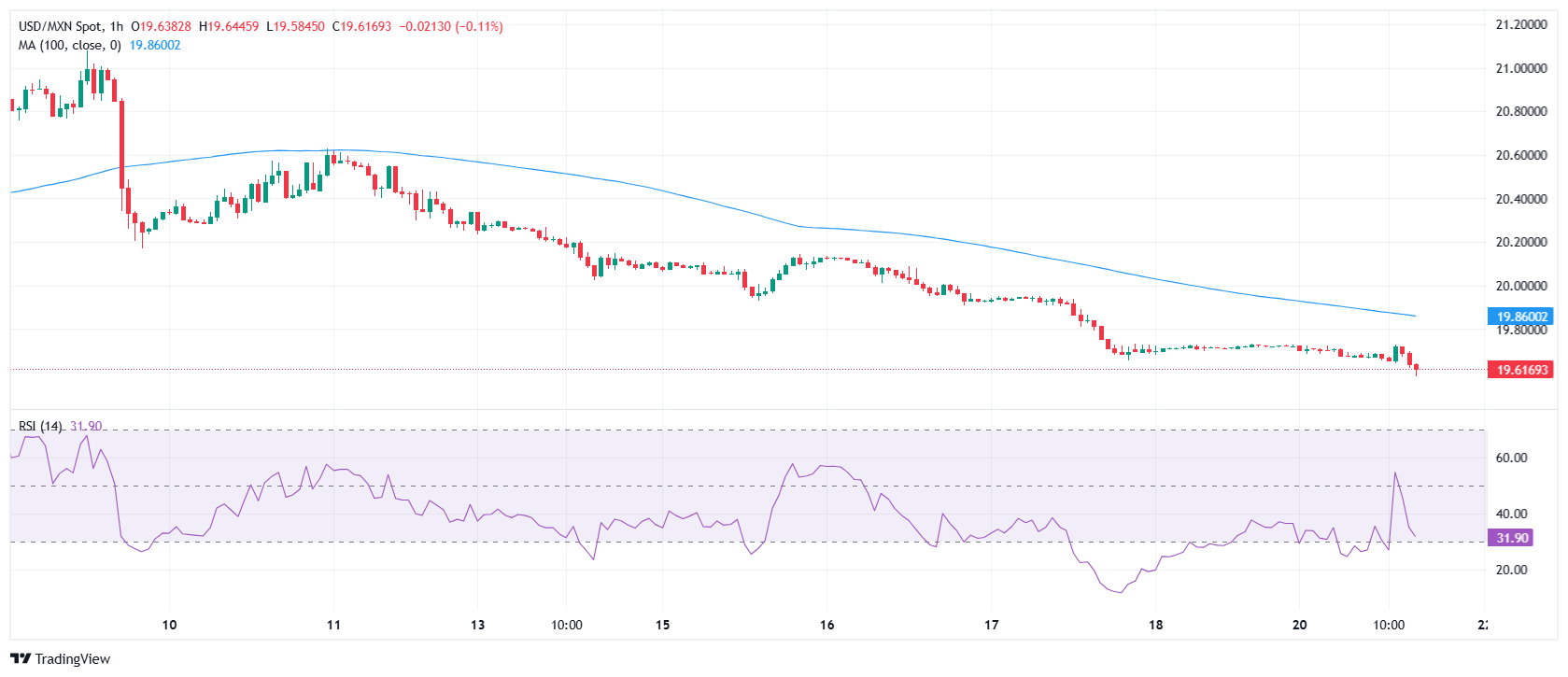- The USD/MXN falls at least six months in 19.61.
- The US dollar records its lowest value since March 2022.
- Donald Trump insists that Jerome Powell, president of the Fed, reducing interest rates.
The USD/MXN is falling this Monday at its lowest price since October 2024. The PAR has descended from a daily maximum tested in the Asian session of 19.72 to a minimum of six months in 19.61 after the American opening.
At the time of writing, the USD/MXN torque quotes about 19.59, losing 0.66% in the day.
Donald Trump re -ask the Fed president to cut the interest rates, the USD/MXN falls
The USD/MXN has accentuated its fall in the last hour, after knowing that the president of the United States, Donald Trump has published in the social network Truth Social that “preventive cuts are being requested in interest rates by many”. Trump has warned that there may be a deceleration of the economy if Powell does not lower the types.
The threats to the independence of the Federal Reserve is weighing on the USD/MXN and have weighed during the day for the dollar, whose DXY index has fallen to 97.91, its lowest level in three years, since March 2022.
The operators of the PAR will be pending in the next few hours of the new statements that Donald Trump can make on the issue of interest rates and on tariffs, but also of the comments of the members of the Federal Reserve. Tomorrow they will speak Patrick Harker, president of the Fed of Philadelphia, and Neel Kashkari, president of the Minneapolis Fed. Both could give clues about the action of the Central Bank at the meeting of next May.
The CME Group Fedwatch tool forecasts at this time that the possibility of a reduction in interest rates in May are 11.8%, raising 75.1% at the June meeting.
On the other hand, this week Mexico will publish its February retail sales data on Wednesday and Inflation figures of the first half of the month on Thursday. For this data, a 0.04% drop in the monthly general CPI and a 0.20% rise in underlying inflation is expected.
USD/MXN Price levels
The USD/MXN tendency in the short term is bassist, with the relative force index (RSI) of 14 approaching overall territory, which could suggest a brief correction in the next few hours.
If you continue falling, the first support waits on 19.11/19.06, October soils and September 2024. A break in the 19.00 psychological zone could lead to the surroundings of 18.40, where it is the minimum of August.
Upwards, the first resistance awaits in the mobile average of 100 periods in time graph, around 19.86. An upward rupture of the region of 20.00 could lead to the torque to the mobile average of 100 in daily graph at 20.35.
1 hour graph of USD/MXN

Mexican weight FAQS
The Mexican weight (MXN) is the most commercialized currency among its Latin American peers. Its value is widely determined by the performance of the Mexican economy, the country’s central bank policy, the amount of foreign investment in the country and even remittance levels sent by Mexicans living abroad, particularly in the United States. Geopolitical trends can also affect MXN: for example, the Nearshoring process (or the decision of some companies to relocate the manufacturing capacity and supply chains closer to their countries of origin) is also considered a catalyst for the Mexican currency, since the country is considered a key manufacturing center in the American continent. Another catalyst for MXN is oil prices, since Mexico is a key exporter of the raw material.
The main objective of the Central Bank of Mexico, also known as Banxico, is to maintain inflation at low and stable levels (in or close to its 3%target, the midpoint of a tolerance band between 2%and 4%). To do this, the bank establishes an adequate level of interest rates. When inflation is too high, Banxico will try to control it by raising interest rates, which makes the indebtedness of homes and companies more cooling, thus cooling the demand and the economy in general. The highest interest rates are generally positive for Mexican weight (MXN), since they lead to higher yields, which makes the country a more attractive place for investors. On the contrary, lower interest rates tend to weaken the MXN.
The publication of macroeconomic data is key to evaluating the state of the economy and can have an impact on the valuation of the Mexican weight (MXN). A strong Mexican economy, based on high economic growth, low unemployment and high confidence is good for MXN. Not only attracts more foreign investment, but it can encourage the Bank of Mexico (Banxico) to increase interest rates, particularly if this fortress is accompanied by high inflation. However, if the economic data is weak, the MXN is likely to depreciate.
As an emerging market currency, the Mexican weight (MXN) tends to rise for periods of risk, or when investors perceive that the general market risks are low and, therefore, are eager to participate in investments that carry a higher risk. On the contrary, the MXN tends to weaken at times of market turbulence or economic uncertainty, since investors tend to sell higher risk assets and flee to the most stable safe shelters.
Source: Fx Street
I am Joshua Winder, a senior-level journalist and editor at World Stock Market. I specialize in covering news related to the stock market and economic trends. With more than 8 years of experience in this field, I have become an expert in financial reporting.







